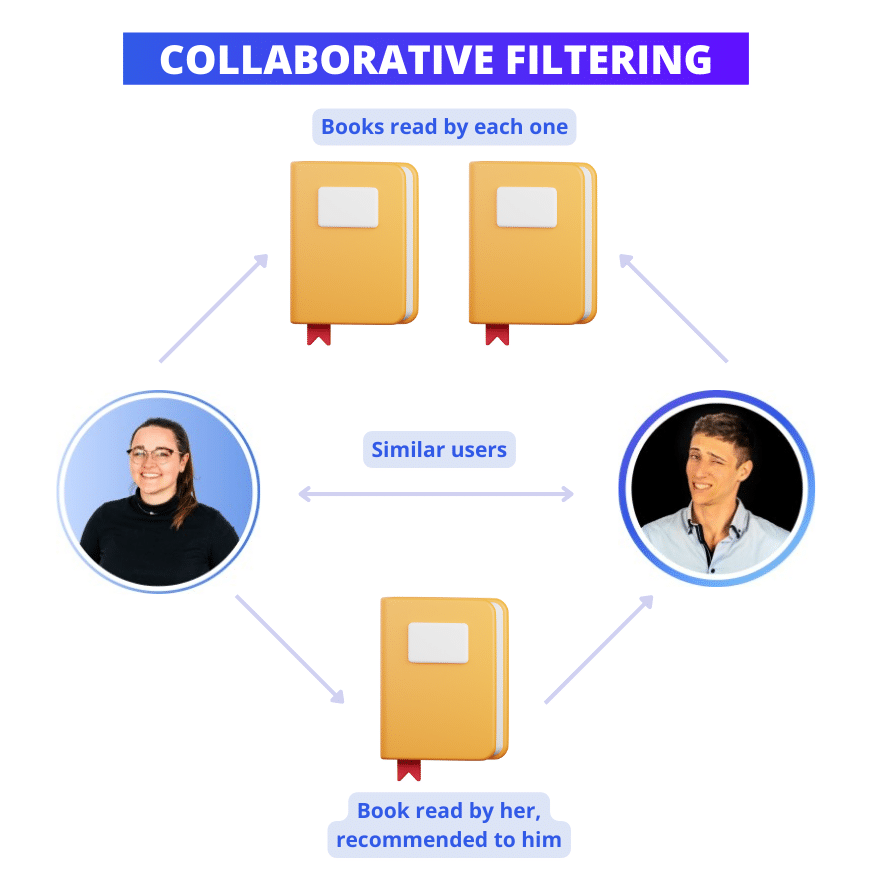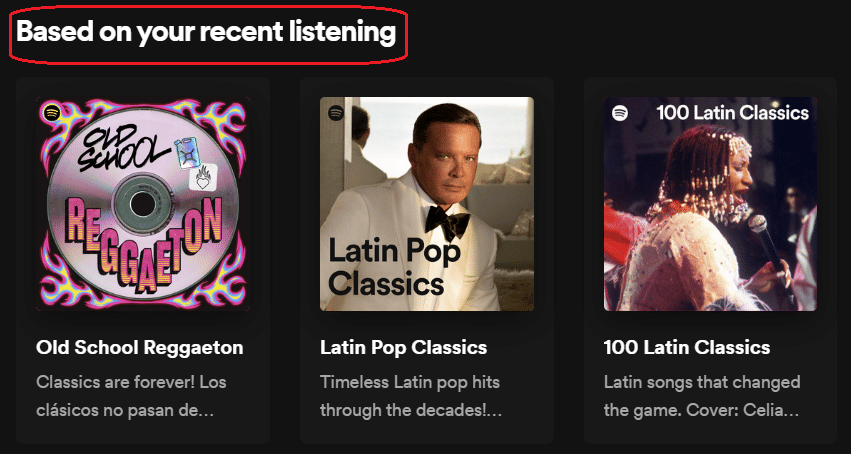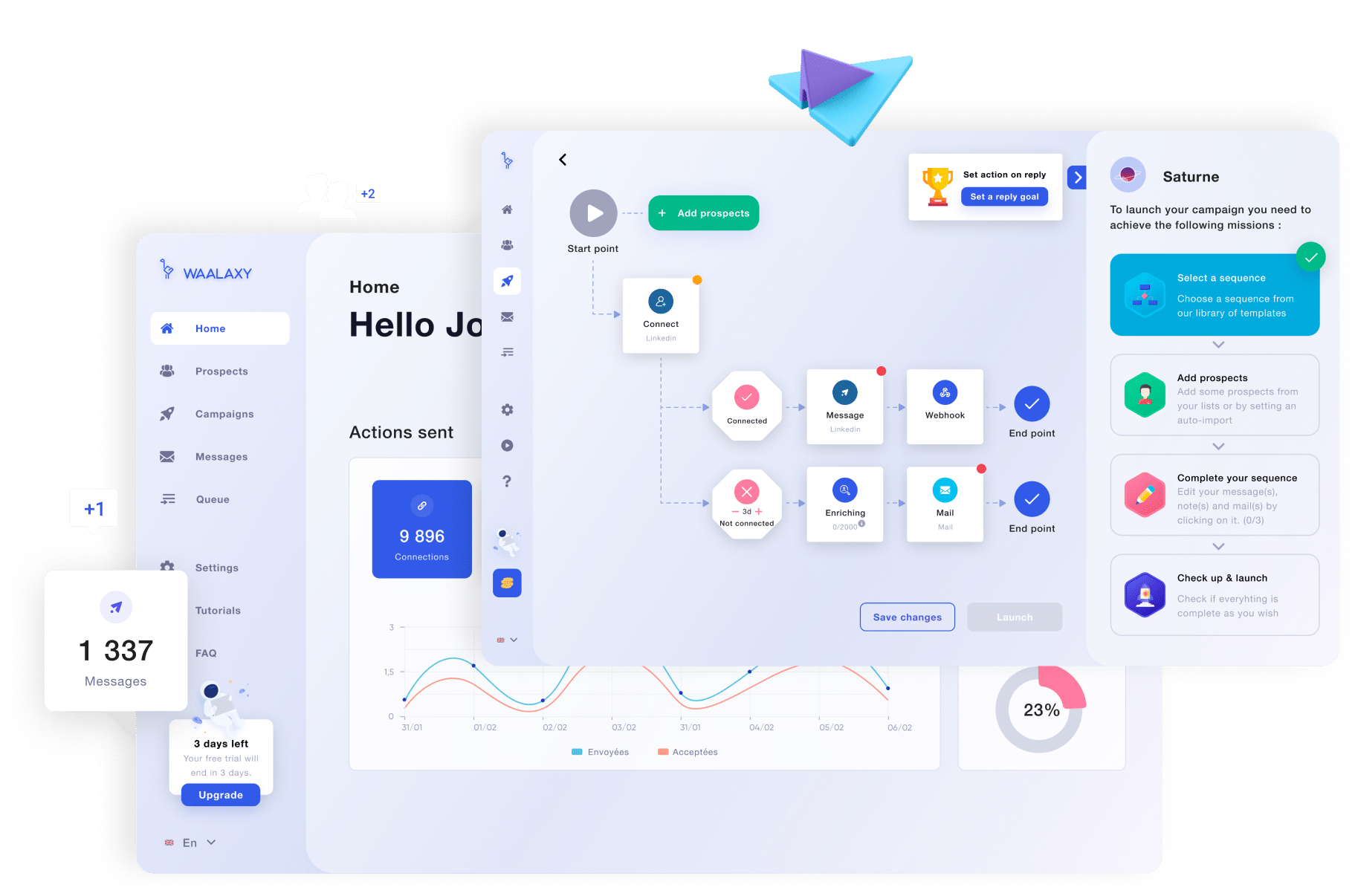Here are a few examples of popular websites and social networks that use Recommendation Engine Algorithms to enhance their user experience: YouTube, Amazon, Netflix, LinkedIn… all will be covered later in this article. Let’s go ! 🚀
Recommendation Engine Algorithms: What is it?
The recommendation algorithm is a set of rules used to select content to suggest to users based on their personal information and data collected on their browsing, purchases, preferences or even online behavior. 🌐
The aim of the recommendation algorithm is to optimize the customer experience by proposing relevant content tailored to their interests, needs and maturity level. 💡 Consequently, this algorithm is widely used in streaming platforms, social networks, e-commerce sites or mobile applications to encourage users to stay longer on the platform and offer them a personalized experience.
The operation of the recommendation algorithm relies on the collection of structured and unstructured data. 🤓 This data can come from search queries, clicks, purchases, user comments or ratings. Then, the algorithm uses this data to identify similar profiles and recommend relevant content based on user preferences.
There are several recommendation algorithm techniques:⏬
-
Content-based filtering: 🔍 this method involves recommending content similar to that which the user has already consulted or purchased. For example, suggesting movies or series similar to those recently watched on a “streaming” platform.
-
Collaborative: 🤝 this method relies on the analysis of relationships between users to recommend content. Based on ratings, reviews or purchases, recommendation engine algorithms can identify users with similar preferences.
-
Machine learning: 🤖 this technique predicts users’ preferences based on their previous behavior. The algorithms continually learn from the data collected, and will then be able to provide more relevant recommendations.
In conclusion, the recommendation algorithm is a powerful tool for improving the user experience. 💪 By identifying user preferences and offering relevant content, platforms can encourage users to stay longer on their site, buy more and improve customer loyalty.

Which Websites use Recommendation Algorithms?
Recommendation engine algorithms have become ubiquitous on the web. 💻 From e-commerce sites to music and video streaming platforms, these algorithms aim to deliver a personalized user experience by recommending products, services or content likely to interest their users.
In this article, we’ll review some of the most popular websites that use recommendation algorithms, such as 👇
-
Amazon: 🛍️ The e-commerce giant uses a highly sophisticated recommendation algorithm that recommends products similar to those you’ve bought or browsed. The algorithm takes into account each user’s purchase and search history, analyzes it using “machine learning ” techniques and constantly maintains a profile of user preferences.
-
Netflix: 📹 The streaming platform is renowned for its ability to recommend series and films tailored to each user. Netflix’s recommendation algorithm draws on previous viewing data, user ratings and reviews, content searches, time of day, language and other factors to recommend titles suited to each user’s tastes.
-
Spotify Recommendation algorithm: 🎶 The Spotify music streaming platform also uses a recommendation algorithm to suggest playlists and songs similar to those listened to by the user. The algorithm takes into account the user’s preferred music genre, most-listened-to songs or artists, and recommendations from friends.
-
YouTube: 📱 Video-sharing site YouTube also uses recommendation algorithms to suggest videos similar to those watched by the user. The algorithm takes into account previously viewed videos, searches carried out by the user, comments and the preferences of other users with similar profiles.
-
LinkedIn Recommendation algorithm: 🔗 The professional networking platform LinkedIn uses a recommendation algorithm to display job offers, relevant connections and articles likely to be of interest to each user. The algorithm uses user profile data, browsing habits and interactions on the platform to generate personalized recommendations.
👉 Indeed, recommendation engine algorithms are used by different types of websites to personalize the user experience. While this may seem intrusive to some, 👀 these algorithms are designed to simplify users’ lives by offering personalized suggestions tailored to their individual preferences.
Examples: Which of these websites use recommendation algorithms?
-
Dropbox recommendation algorithm:
Dropbox 🎁 uses a recommendation algorithm to help users find files relevant to their needs. The algorithm recommends files based on the user’s past actions and the actions of other similar users.
How Dropbox’s recommendation algorithm works is relatively straightforward. 🧠 Each user’s file monitored for actions such as opening, modifying and sharing. With this information, Dropbox’s recommendation algorithm can use techniques such as collaborative recommendation or content-based recommendation :
- In the case of collaborative recommendation, Dropbox’s recommendation algorithm uses the actions of users with similar behavior to recommend relevant files. 🧐 For example, if two users have modified and included the same file in their recent work, the algorithm recommends this file to these users.
- In the case of content-based recommendation, the algorithm identifies similar files by analyzing the content of files that have been opened or modified by the user. 🧐 For example, if a user works mainly on documents relating to finance and budgets, the recommendation algorithm recommends similar files (in the field of finance and accounting) to the user.
In addition to this, Dropbox’s recommendation algorithm is also able to take into account other factors such as frequency of use, popularity and file size before recommending a file to a user.
👉 Ultimately, Dropbox’s recommendation algorithm uses multiple techniques to recommend the most relevant files to a user. ✅ Using this recommendation algorithm allows Dropbox users to discover new files, improve their productivity and easily access the files that matter most to them.
-
Amazon Recommendation algorithm:
Amazon 🛒 uses the recommendation algorithm to deliver a personalized experience for every user. 😏 This algorithm collects a considerable amount of data (known as reliable sources), such as shopping habits, recent searches and products viewed to suggest similar or complementary products.
Amazon’s recommendation algorithm also uses collaborative filtering to assess the buying tendencies of similar users, then recommend these products to other users with similar buying behaviors.
In addition, Amazon has developed a specific algorithm called “Item-to-Item Collaborative Filtering”, which is a product-based collaborative filtering algorithm. 🧐 This recommendation algorithm uses users’ purchase history data to correlate purchased products and then recommends complementary products.
👉 For example, if a user buys a book on the Python language, Amazon will recommend other books on Python or books on programming.
Alongside this, Amazon has introduced a system of “weekly purchase recommendations” that suggests products based on the user’s tastes. 🍝 This is achieved by collecting information on wish lists, ratings and reviews left by customers.
Also, Amazon’s recommendation algorithm also suggests products based on frequent purchases or top-rated products. ⭐
The effect of this recommendation algorithm is undeniable, allowing users to discover new products while offering a personalized shopping experience. 💡 Indeed, the AI-based recommendation algorithm is one of Amazon’s great technological successes and has helped make the company one of the most influential players in the world of online sales.

Does Wikipedia use a recommendation algorithm?
-
Wikipedia recommendation algorithm :
Wikipedia 🔎 uses the recommendation algorithm to direct users to pages that might be of interest to them, in the hope of increasing their time spent on the site and therefore their rate of engagement. Wikipedia uses several different types of recommendation algorithm, each with its own purpose and method of selecting content to recommend.
One of the popular algorithms used by Wikipedia is called “Collaborative Filtering”. This recommendation algorithm analyzes each user’s past activities on the site to recommend content that will suit their tastes.
For example, if a user has spent a lot of time reading articles on philosophy, the recommendation algorithm will probably suggest similar articles on related topics. 💡 By using this method, Wikipedia helps keep its users engaged by offering personalized content that caters to their interests.
Wikipedia also uses recommendation engine algorithms based on factors such as most-read articles, most-recent articles, those most relevant to the search topic and those with the highest ratings. 🌟 These algorithms are able to sort Wikipedia’s various articles into various categories and recommend them based on search relevance or user interest.
Finally, Wikipedia uses a recommendation algorithm based on page popularity. 💹 This algorithm examines the number of views, the rate of conversion from a passive visitor to an active reader of the article, as well as interactions between the user and the pages visited, enabling Wikipedia to recommend the pages that have generated the most engagement for new visitors.
👉 In general, Wikipedia’s recommendation algorithm can recommend articles on similar topics using collaborative filtering, relevance and popularity techniques. These techniques enable Wikipedia to offer users relevant articles that may be useful to them, enhance their experience on the site and encourage them to spend more time there.
How does Spotify use Artificial Intelligence?
-
Spotify uses recommendation algorithms:
Spotify 🎵 has revolutionized the way people listen to music online, and one of the main drivers of their success is their recommendation algorithm. This algorithm allows Spotify to recommend songs and artists similar to those the user usually listens to. Here’s how it works: ⏬
- First, Spotify collects a massive amount of user data, recordings, playlists, millions of hours of recorded music. 🎧 They then use this data to train machine learning models capable of predicting users’ musical preferences.
- Spotify’s recommendation algorithm then uses these models to compare the musical characteristics of different songs and artists. 🎤 They use features such as tempo, key, melody, instruments, lyrics and other attributes of the music.
- Using these characteristics, the recommendation algorithm ranks songs according to their “similarity” to other songs and artists. 🤩 Several factors can be taken into account for this comparison, e.g. popularity of the song or artist, geographical proximity, correspondence with playlists or musical genres, etc.
- Based on these classifications, Spotify can recommend songs and artists similar to those the user already listens to. 👂 When the user listens to a song, Spotify analyzes its song history and suggests playlists and albums accordingly.
👉 Using Spotify’s recommendation algorithm, users can discover new artists and sounds they might never have found otherwise. 💯 The algorithm underpins Spotify’s expertise as a playlist creator, whether it’s personalized playlists, quick exercise playlists or song packs for specific music genres.
In conclusion, Spotify’s recommendation algorithm is a key element of their marketing strategy and customer acquisition channels. 🗝️ It enables the company to build user loyalty by offering them content they like and helping them discover new artists and songs. 🧐 This is an example of the successful use of artificial intelligence and machine learning to enhance the user experience.

-
Waalaxy uses the same recommendation algorithm as Spotify:
As explained before, Spotify ‘s recommendationAI uses advanced algorithms to analyze your viewing habits and provide personalized recommendations. Similarly, Waalaxy considers 10 lead searches and recommends up to 1,000 similar profiles. 👀
Here are the actions you can take with our AI “Prospect Finder”: ⏬
- Collect from data on the habits of your habits.
- Analyze the characteristics of potentical customers.
- Pre-process and clean the data, then you can organize it.
- Create your models models à using of techniques machine techniques. 👀
- The recommendations are based on of criteria and criteria and behavior of prospects selected.
- Collect from feedback to refine the model and improve the recommendations. 🔥
(Just like Spotify does for the music you listen to 😉)
Here’s a little explainer video for more info: 👇
Conclusion: Recommendation Engine Algorithms and AI
The Recommendation Algorithm is a key component of Artificial Intelligence (AI), enabling companies to personalize product or service recommendations for each user based on data collected about their past online behavior. 🔍
✔️ Algo analyzes user data, including demographics, online browsing habits, purchasing trends, online interactions and search histories to provide personalized, relevant recommendations.
It typically uses two main methods: content-based recommendation and collaborative recommendation. ⚡
- Content-based recommendation uses demographic data, online behaviors and search histories to provide relevant recommendations for each user. This approach is often used by e-commerce sites, social networks and search engines to deliver relevant search results, targeted advertising and personalized product recommendations.
- Collaborative recommendation uses data collected from other users with similar interests to recommend products to the user. This approach is often used in music streaming sites and video-on-demand platforms to recommend relevant content and related products.
👉 Ultimately, the aim of the Recommendation Algorithm is to provide a personalized and satisfying user experience that increases sales and customer satisfaction. 💕 However, it is essential to take users’ preferences and privacy concerns into account when using the Recommendation Algorithm to avoid any negative consequences. 🙈
FAQ : Recommendation algorithms
How does the recommendation algorithm work?
The recommendation algorithm typically uses a combination of data processing and machine learning techniques to analyze user data and use it to suggest relevant items. 🚀
-
Data collection: the algorithm gathers user data such as purchase history, product reviews and browsing habits.
-
Data analysis: Collected data is analyzed to identify patterns, trends and user preferences.
-
Construction of user profiles: The algorithm creates user profiles based on the data collected. These profiles are used to understand user preferences, needs and habits.
-
Recommendation: With these user profiles in place, the algorithm can recommend products or content tailored to the user’s preferences. In addition, the algorithm uses collaborative filtering techniques to recommend items similar to those the user has enjoyed in the past.
-
Recommendation evaluation: The algorithm continually evaluates recommendations to ensure they are effective and appropriate.
Basically, the recommendation algorithm uses users’ data to anticipate their needs or preferences and offer suitable suggestions. 👌 This helps improve the user experience and can increase sales or site traffic.
What tasks can AIs perform?
Artificial intelligences have the potential to perform all kinds of tasks, from data manipulation to sentiment analysis to language translation. Here are just a few examples of what AIs can do:
-
Data analysis: AIs can process large amounts of data in a short space of time, identifying patterns and trends. This makes them ideal choices for marketing and financial data analysis.
-
Virtual assistance: AIs can provide automatic support for interactive users in applications. Chatbots, for example, are artificial intelligence programs designed to interact with users in a conversational manner.
-
Image and voice recognition: AIs are very good at image and voice recognition, as is the case for photo applications, facial recognition, character recognition or voice recognition.
-
Language translation: AIs are capable of translating languages instantly, and with increasing accuracy, making them useful for companies focused on international trade.
-
Sentiment analysis: AIs can also be used to analyze sentiments expressed online on social networks, for example, using machine learning algorithms to identify users’ positive or negative emotions.
In fact, artificial intelligences are capable of performing a wide range of tasks, reflecting their adaptability and versatility in the fields of business, research and technological development. 🤖
How can you make money with AI?
The use of artificial intelligence (AI) can open up revenue opportunities for investors and entrepreneurs. 🤑 Firstly, companies will use AI to improve efficiency by automating repetitive tasks and reducing human error. 😥
This can reduce costs and improve the quality of products and services. What’s more, AI-powered chatbots and virtual assistants are increasingly being used to respond to customer needs 24/7, increasing customer satisfaction and loyalty. 😍
- Secondly, AI is being used in online advertising to target ads based on consumer preferences, increasing the likelihood that these ads will be effective. 🎯 Companies can also use AI systems to analyze large datasets to develop new marketing or sales strategies.
- Money can also be made by creating specialized applications, such as voice assistants for the smart home, speech recognition software for transcriptions or investment advice based on data processing algorithms.
In conclusion, AI is a fast-growing technology that offers many revenue opportunities for businesses and entrepreneurs, and there is no doubt that new use cases will emerge in the future. 👀

That’s it! Now you know all about the Recommendation engine algorithms. 😏








